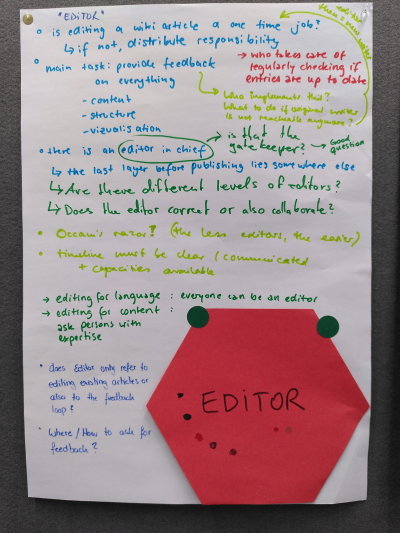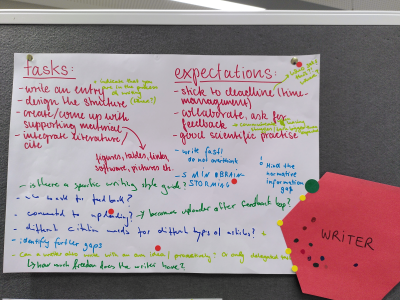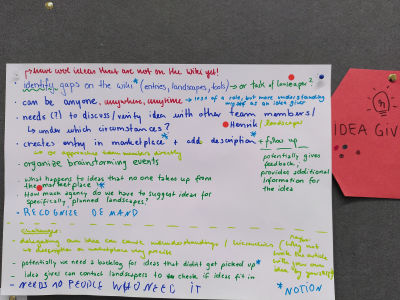Silent Debate/Silent Discussion
| Type | Team Size | ||||||
|---|---|---|---|---|---|---|---|
| Group Collaboration | The Academic System | Software | 1 | 2-10 | 11-30 | 30+ | |
In short: Silent debate is a great tool to do group work without labeling it as such, to involve shy or more passive students, and to have a written account of the discussion in the end. In what follows we use the term 'silent debate', although it could also be called 'silent discussion'.
What is a silent debate?
Silent debate is a method to activate and engage participants, such as students, in a discussion about one or more topics of interest (Kräger 2018, Lehnert 2023). Pre-prepared topics or prompts are presented to the participants via posters or digitally with the use of digital software (Sloggett 2016). The participants are then asked to react to the topics or prompts and to write or type their opinions in a first phase, the writing phase, in which they are not allowed to speak. They can also comment on each other's contributions. The results of the writing phase are displayed or projected for all to see. The facilitator, e.g. a lecturer, can read out all or a selection of the written thoughts, initially without comment or evaluation. In the second evaluation phase, the results and open questions are discussed. The method is suitable for small groups as well as for events with many participants such as lectures (Kräger 2018, Lehnert 2023). In addition to its flexibility, the method is characterized by the high probability that all participants will participate in the exchange and discourse.
Goals of silent debate
Silent debate is designed to help participants develop their own views on complex issues (Sloggett 2016). Participants may have difficulty engaging with complex issues or even find the idea of contributing in a spoken discussion intimidating. A silent debate ensures that everyone has their 'say' without the fear of actually speaking. They are encouraged to think about their own position on an issue. Silent debate is also linked to the idea of “Schreibdenken” (thinking in writing). This refers to formulating new thoughts by writing rather than speaking. It involves improved writing skills and new ways of concentrating on learning. As participants reflect on their own knowledge, thoughts and experiences in a silent debate, they are also inspired, challenged and encouraged by the contributions of others (Kräger 2018, Lehnert 2023). The aims are multiple, ranging from activating prior knowledge and brainstorming to engaging in a written dialogue with others. It promotes understanding of other people's views and the reasons for them. Silent debate can also be fun, as pupils may enjoy getting up and moving around the classroom to comment on other pupils' views (Sloggett 2016).
When to use it
This approach can be used for a variety of purposes, such as:
- introducing content related topics
- generating ideas
- testing the state of knowledge
- encouraging exchange
- giving feedback, evaluating or closing a seminar, lecture, meeting
- capturing the mood
Getting started
The facilitator's main task is to prepare questions, theses or prompts and materials. It is also necessary to present and explain the method before the writing phase to ensure that everyone understands the importance of silence during the first phase. Moderation of the process and evaluation in the second phase is also required. For the analogue version, you will need a room or lecture hall with enough space for participants to move around and the possibility to put up posters or metaplan boards. Depending on the number of participants, different posters (with theses, prompts or questions) are useful. Prepare one or more posters with theses, prompts or questions written on them as headings. The posters are placed on tables or hung on walls, blackboards, metaplan boards or flipchart stands. Pencils are provided for all participants. Remember to have enough pens for all participants. You may want to use different colours.
To conduct a silent debate digitally, you will need digital brainstorming, mind-mapping and text-writing software, such as Miro or Collaboard. One or more theses, prompts or questions are prepared and integrated into the software as headings. Another requirement is internet access and availability for all participants, who will need to bring internet-enabled mobile devices (smartphones, tablets, laptops). They must be informed in advance of the planned silent debate. All participants will receive the link to the writing software and, if necessary, a short introduction on how to use the software. In addition, digital presentation facilities (projector, laptop) may be useful.
Optionally, you can use a countdown timer or a stopwatch to keep track of time.
Procedure of a silent debate
1. Introduction to the method
First, the facilitator explains the method. The participants are asked to share their thoughts, knowledge, reflections, experiences, etc. on a topic/issue/question by writing them on the posters or in the corresponding software. The method consists of two phases: 1. A silent debate (= writing phase, about 5-10 minutes per poster) and 2. An evaluation phase (about 15-30 minutes). The time can be adjusted individually.
2. Writing phase – the silent debate
In the analogue version, the participants gather around the posters whereas in the digital version, they access the software. The participants have 5 to 10 minutes to answer the respective question or to respond to the thesis and to write their knowledge, assessments, experiences, opinions and reflections on the poster. They can comment on each other's contributions in written form, without being too detailed or long. After about 5 to 10 minutes, the participants move to the next poster to read and comment on the written debate of the previous group. Most importantly, they are not allowed to talk to each other during the writing phase. They only exchange their thoughts in writing and add to them or correct each other.
Variation: For the writing phase, the number of posters is not limited. In the case of many participants more posters/questions may be useful to ensure that all participants can contribute individually to the posters. It is also possible to structure the writing phase more freely and allow participants to move between different posters.
3. Evaluation phase – end of the silent round
After the writing phase, the edited posters are hung up in the room or lecture hall for all to see, or, if it's a fully digital setting, the board is shared with everyone, e.g. via a shared screen. In smaller groups, the facilitator can read out all the written thoughts, initially without comment or evaluation. In larger groups, a selection of aspects is usually required. Afterwards, the facilitator and the participants can ask questions and relate and discuss aspects.
Variation: Especially in events with many participants, it can be a challenge for the facilitator to grasp, classify and address the many contents noted on the posters. In this case, it would be possible to follow the writing phase with a group work or focus group phase, i.e. groups could be given the task of summarizing or clustering the content of a poster before continuing the discussion and overall evaluation in plenary.
Challenges
It can be challenging to come up with a series of ten or so thought-provoking statements on the topic(s) you want participants to grasp. This step takes time and requires consideration of the age and ability of the participants. It also depends very much on the aim you have in using this approach. The silent debate needs to be carefully prepared and the facilitator's role is to give clear instructions. Moving around the room can also be a challenge, especially if many participants move at the same time. This requires good planning of how the physical space is used.
Normativity
The choice of topics and prompts is based on the facilitator's preferences and decisions and is therefore deeply normative. The normativity of the method is also evident in the participants' comments, which are based on their experiences, values and opinions.
In sum
- Silent debate is a great way to motivate more silent participants to contribute and to encourage active discussion around a topic of interest.
- It is divided into the silent writing phase and the subsequent evaluation phase.
- A successful silent debate requires good preparation, a goal, and a facilitator who is aware of their role.
Literature and Further Information
Kräger, C. (2018). Updated by Lehnert, S. (2023). Methodological profile: Silent debate/Silent discussion. Leuphana Teaching Service. https://www.leuphana.de/fileadmin/user_upload/portale/lehre/02_Lehre-konzipieren/Stille-Debatte-Methodensteckbrief_Handreichung_EN.pdf
Schäffer, T. (2009). Stumme Diskussion. In Leão. A. & Hofmann, M. (Hrsg.), *Fit for Change II. 40 praxisbewährte Tools und Methoden im Change für Trainer, Moderatoren, Coaches und Change Manager* (S. 224–230). managerSeminare. https://teachingtools.uzh.ch/de/tools/stumme-diskussion
Sloggett, G. The silent debate. In: Teaching Geography. Geographical Association. Volume 41, Edition 1. (Spring 2016): 22-23. https://portal.geography.org.uk/downloads/journals/TG_SPR_2016_SLOGGETT.pdf
Silent debate (In HD) | Teaching and Learning. https://www.youtube.com/watch?v=Bjopx_Ju0eE
The author of this entry is Joanna Knecht.


